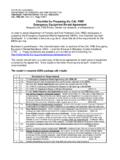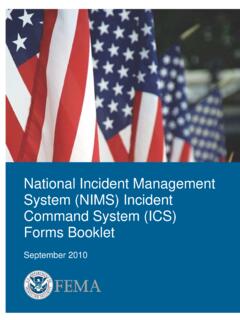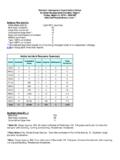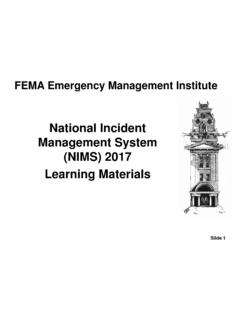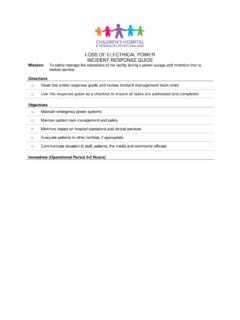Transcription of Firefighter Type 1 (FFT1), Incident Commander Type 5 (ICT5)
1 A Publication of the National Wildfire Coordinating Group NWCG Task Book for the Positions of: Firefighter TYPE 1 ( fft1 ) Incident Commander TYPE 5 (ICT5) (POSITION PERFORMANCE REQUIRED ON A WILDFIRE ASSIGNMENT) PMS 311-14 JUNE 2009 Task Book Assigned To: Trainee s Name: _____ Home Unit/Agency: _____ Home Unit Phone Number: _____ Task Book Initiated By: Official s Name: _____ Home Unit Title: _____ Home Unit/Agency: _____ Home Unit Phone Number: _____ Home Unit Address: _____ Date Initiated: _____ The material contained in this book accurately defines the performance expected of the position for which it was developed. This task book is approved for use as a position qualification document in accordance with the instructions contained herein.
2 2 Verification/Certification of Completed Task Book for the Position of: Firefighter TYPE 1 Final Evaluator s Verification To be completed ONLY when you are recommending the trainee for certification. I verify that (trainee name) _____ has successfully performed as a trainee by demonstrating all tasks for the position listed above and should be considered for certification in this position. All tasks are documented with appropriate initials. Final Evaluator s Signature: _____ Final Evaluator s Printed Name: _____ Home Unit Title: _____ Home Unit/Agency: _____ Home Unit Phone Number: _____ Date: _____ Agency Certification I certify that (trainee name) _____ has met all requirements for qualification in the above position and that such qualification has been issued.
3 Certifying Official s Signature: _____ Certifying Official s Printed Name: _____ Title: _____ Home Unit/Agency: _____ Home Unit Phone Number: _____ Date: _____ Additional copies of this publication are available through: NWCG, Publications Management System at 3 Verification/Certification of Completed Task Book for the Position of: Incident Commander TYPE 5 Final Evaluator s Verification To be completed ONLY when you are recommending the trainee for certification. I verify that (trainee name) _____ has successfully performed as a trainee by demonstrating all tasks for the position listed above and should be considered for certification in this position. All tasks are documented with appropriate initials.
4 Final Evaluator s Signature: _____ Final Evaluator s Printed Name: _____ Home Unit Title: _____ Home Unit/Agency: _____ Home Unit Phone Number: _____ Date: _____ Agency Certification I certify that (trainee name) _____ has met all requirements for qualification in the above position and that such qualification has been issued. Certifying Official s Signature: _____ Certifying Official s Printed Name: _____ Title: _____ Home Unit/Agency: _____ Home Unit Phone Number: _____ Date: _____ NATIONAL WILDFIRE COORDINATING GROUP (NWCG) POSITION TASK BOOK NWCG Position Task Books (PTBs) have been developed for designated National Interagency Incident Management System (NIIMS) positions. Each PTB lists the competencies, behaviors and tasks required for successful performance in specific positions.
5 Trainees must be observed completing all tasks and show knowledge and competency in their performance during the completion of this PTB. Trainees are evaluated during this process by qualified evaluators, and the trainee s performance is documented in the PTB for each task by the evaluator s initials and date of completion. An Evaluation Record will be completed by all evaluators documenting the trainee s progress after each evaluation opportunity. Successful performance of all tasks, as observed and recorded by an evaluator, will result in a recommendation to the agency that the trainee be certified in that position. Evaluation and confirmation of the trainee s performance while completing all tasks may occur on one or more training assignments and may involve more than one evaluator during any opportunity.
6 Incident /EVENT CODING Each task has a code associated with the type of training assignment where the task may be completed. The codes are: O = other, I = Incident , W = wildfire, RX = prescribed fire, W/RX = wildfire OR prescribed fire and R = rare event. The codes are defined as: O = Task can be completed in any situation (classroom, simulation, daily job, Incident , prescribed fire, etc.). I = Task must be performed on an Incident managed under the Incident Command System (ICS). Examples include wildland fire, structural fire, oil spill, search and rescue, hazardous material, and an emergency or non-emergency (planned or unplanned) event. W = Task must be performed on a wildfire Incident . RX = Task must be performed on a prescribed fire Incident .
7 W/RX = Task must be performed on a wildfire OR prescribed fire Incident . R = Rare events such as accidents, injuries, vehicle or aircraft crashes occur infrequently and opportunities to evaluate performance in a real setting are limited. The evaluator should determine, through interview, if the trainee would be able to perform the task in a real situation. While tasks can be performed in any situation, they must be evaluated on the specific type of Incident /event for which they are coded. For example, tasks coded W must be evaluated on a wildfire; tasks coded RX must be evaluated on prescribed fire and so on. Performance of any task on other than the designated assignment is not valid for qualification. 4 Tasks within the PTB are numbered sequentially; however, the numbering does NOT indicate the order in which the tasks need to be performed or evaluated.
8 The bullets under each numbered task are examples or indicators of items or actions related to the task. The purpose of the bullets is to assist the evaluator in evaluating the trainee; the bullets are not all-inclusive. Evaluate and initial ONLY the numbered tasks. DO NOT evaluate and initial each individual bullet. A more detailed description of this process and definitions of terms are included in the Wildland Fire Qualification System Guide, PMS 310-1. This document can be found at RESPONSIBILITIES The responsibilities of the Home Unit/Agency, Trainee, Coach, Training Specialist, Evaluator, Final Evaluator and Certifying Official are identified in the Wildland Fire Qualification System Guide, PMS 310-1. It is incumbent upon each of these individuals to ensure their responsibilities are met.
9 INSTRUCTIONS FOR THE POSITION TASK BOOK EVALUATION RECORD Evaluation Record # Each evaluator will need to complete an evaluation record. Each evaluation record should be numbered sequentially. Place this number at the top of the evaluation record page and also use it in the column labeled Evaluation Record # for each numbered task the trainee has satisfactorily performed. Trainee Information Print the trainee s name, position on the Incident /event, home unit/agency, and the home unit/agency address and phone number. Evaluator Information Print the Evaluator s name, position on the Incident /event, home unit/agency, and the home unit/agency address and phone number. Incident /Event Information Incident /Event Name: Print the Incident /event name.
10 Reference: Enter the Incident code and/or fire code. Duration: Enter inclusive dates during which the trainee was evaluated. Incident Kind: Enter the kind of Incident (wildfire, prescribed fire, search and rescue, flood, hurricane, etc.). Location: Enter the geographic area, agency, and state. Management Type or Prescribed Fire Complexity Level: Circle the ICS organization level (Type 5, Type 4, Type 3, Type 2, Type 1, Area Command) or the prescribed fire complexity level (Low, Moderate, High). 5 6 Fire Behavior Prediction System (FBPS) Fuel Model Group: Circle the Fuel Model Group letter that corresponds to the predominant fuel type in which the Incident /event occurred. G = Grass Group (includes FBPS Fuel Models 1 3): 1 = short grass (1 foot); 2 = timber with grass understory; 3 = tall grass (1 - 2 feet) B = Brush Group (includes FBPS Fuel Models 4 6): 4 = Chaparral (6 feet); 5 = Brush (2 feet); 6 = dormant brush/hardwood slash; 7 = Southern rough T = Timber Group (includes FBPS Fuel Models 8 10) 8 = closed timber litter; 9 = hardwood litter; 10 = timber (with litter understory) S = Slash Group (includes FBPS Fuel Models 11 13) 11 = light logging slash; 12 = medium logging slash; 13 = heavy logging slash Evaluator s Recommendation For 1 4, initial only one line as appropriate; this will allow for comparison with your initials in the Qualifications Record.




